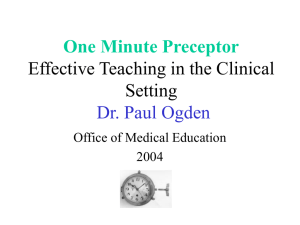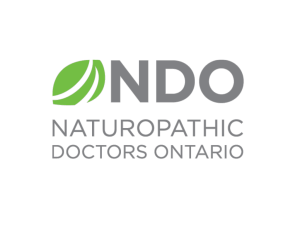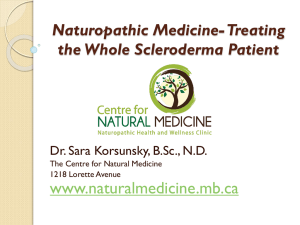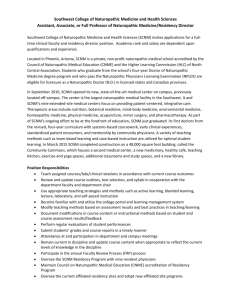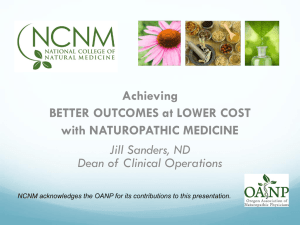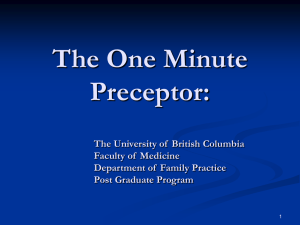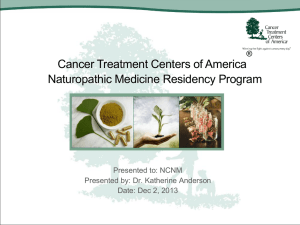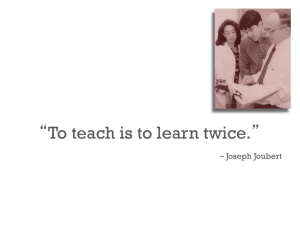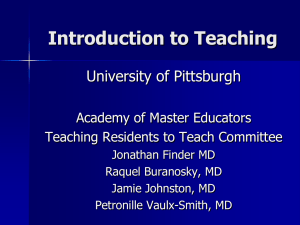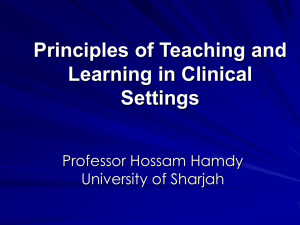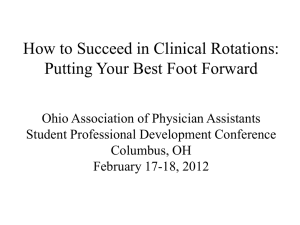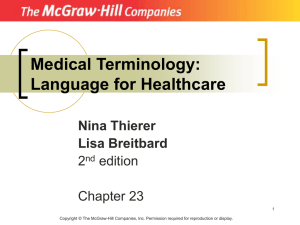The One Minute Preceptor for Natural Medicine
advertisement
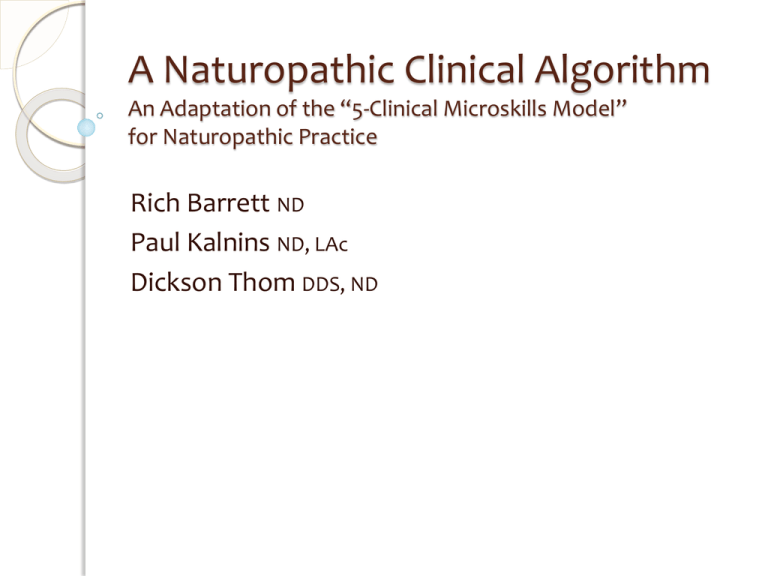
A Naturopathic Clinical Algorithm An Adaptation of the “5-Clinical Microskills Model” for Naturopathic Practice Rich Barrett ND Paul Kalnins ND, LAc Dickson Thom DDS, ND Plan Rich Barrett presents the 5 Microskills model Dick Thom and Jeremy Mikolai will role play a clinical preceptor encounter Paul Kalnins will present a naturopathic version of the 5 microskills Dick Thom and Jeremy Mikolai will continue their role play The Problem Clinical teaching is challenging ◦ We have to diagnose and treat our patients ◦ We typically do this through an intermediary, a medical student or resident. ◦ We also have to diagnose and teach these learners New information and clinical reasoning Clinical teaching skills are not innate The thorough examination of clinical teaching by Koen and Vivian identified five major modes and 18 micro skills in effective clinical teaching John Neher and colleagues at the University of Washington in collaboration with Koen pared these to Five “microskills” Advantages of the 5 Microskills Focuses the consultation on the decision-making process used by the medical student Reveals the fund of knowledge available to the student Designed to be efficient: most encounters take about five minutes Can vary according to the complexity of the case and the needs of the student The 5 Microskills 1. 2. 3. 4. 5. Get a commitment Probe for supporting evidence Teach general rules Reinforce what was done right Correct mistakes First Microskill: Get a commitment Student presents the history, physical findings and any labs available Early in the consultation they should be encouraged to make a commitment to a diagnosis, workup, or therapeutic plan Gives student more responsibility for patient care Encourages them to process and analyze information gathered from the encounter Get a commitment Failure to commit may indicate a student has not processed the information, is afraid to expose a weakness, or is dependent on the thinking of others It is critical that the environment be supportive to promote intellectual honesty It’s better before the learner to be incorrect, than not commit. Being wrong is a learning opportunity Get a commitment The cue for this microskill occurs when the student presents the facts of the case, and then pauses, waiting for interpretation from the attending physician Resist the urge to fill in the verbal blank! Instead ask: ◦ What do you think is going on with this patient? ◦ What laboratory tests do you think are indicated? Second Microskill: Probe for supporting evidence Find out what evidence supports this commitment “ What were the major findings that led to your diagnosis?” What other diagnoses did you consider? What kept you from that choice? By having the student “think out loud” the preceptor can identify what the student knows and does not know Third Microskill: Teach general rules This step allows the teacher to generate and communicate a general teaching point resulting from the case A teaching point will be apparent from their omissions or mistakes Instruction is more memorable and more transferable to other cases when it is offered as a general rule Fourth Microskill: Reinforce what was done right Rewards competence Builds professional self-esteem Caveat: Avoid general praise which reinforces no particular behavior i.e. “ You did a good job” Both praise and criticism need to be as specific as possible Fifth Microskill: Correct mistakes Do this last Choose the appropriate time and place Vague, judgmental statements such as “This case was badly mismanaged” are not helpful or appropriate It is generally a good idea to ask the student to critique their own performance first Suggest outside reading or other learning Studies supporting the use of the five-step multiskills model: Aagard, Salerno, Furney, Jones, Tehernani Faculty rated Microskills more efficient Increased likelihood of the correct diagnosis Twice as much higher order verbal feedback Higher quality and quantity written feedback Students were more motivated to do outside reading Case Example using the Five-Step Microskills with a Resident at the NCNM Clinic 40 Year Old White Female CC: Gas/bloating, constipation, right upper quadrant pain, hyperlipidemia The 5 Microskills 1. 2. 3. 4. 5. Get a commitment Probe for supporting evidence Teach general rules Reinforce what was done right Correct mistakes Biomedical 5-Clinical Microskills Model Get a commitment Probe for supporting evidence Teach general rules Reinforce what was right Correct mistakes Advantages for Clinical Training Engages the student in the thinking and decision processes Attempt is made at gathering the best available evidence Builds a student’s confidence Fosters a genuine collaborative approach between all members of a patient’s treatment team Disadvantages for Naturopathic Medicine Approach is based on the biomedical disease model: Once diagnosis is made, treatment protocols are often established Not reflective of naturopathic approach to preventative care and wellness (naturopathic wellness model) Naturopathic treatments often based on factors independent of the disease diagnosis What is the Naturopathic Approach to Patient Care? Benedict Lust ND, DO, MD (1872-1945) Founded naturopathic medicine (~1902) & first naturopathic medical school Roots in European “Nature Cure” movement Amalgamated many medical traditions & techniques: Hydrotherapy Physical medicine Herbal medicine Homeopathy Diet therapy Core Concepts of Naturopathy First do no harm Respect the Vis medicatrix naturae Identify & treat the causes Doctor as teacher Treat the whole person Prevention Vis medicatrix naturae, “Healing power of nature” Self-regulatory mechanisms in the organism Modern interpretation: milieu interieur (Bernard, 1985), homeostasis (Cannon, 1930’s) Role of psycho-neuro-endocrine-immune system Naturopathic practice: identify & remove factors inhibiting the Vis medicatrix Restore homeostasis What is the Naturopathic Approach to Patient Care? A Functional Approach to Illness History Physical Tests Biomedical Assessment/Diagnosis Migraine with Aura Biomedical Treatment Diet/lifestyle/exercise Medications Triptans NSAIDS Ergot derivatives Beta-blockers Calcium channel blockers Antidepressants Antiseizure medications Etc. Naturopathic Assessment/Diagnosis Naturopathic Treatment Hepatic-Biliary General Support Dietary changes Lifestyle/exercise Stress reduction Self-care techniques Poor liver phase I & II detoxification? Cholestasis? Digestive Pro-inflammatory diet/food triggers? Food allergies/sensitivities? Integrity of intestinal mucosa? Nervous-Endocrine HPA-axis/cortisol dysregulation? Poor clearance of estrogen metabolites? Poor methylation processes? Lack of neurotransmitter clearance? Cardio-Circulatory Endothelial dysfunction? Cardiovascular inflammation? Renal Poor renal elimination of metabolites? Subtle acid-base balance shifts? Structural Head/neck structural or soft-tissue issues? Specific Support Botanical medicine Homeopathic medicine Essential fatty acids Vitamins/minerals Etc. Physical Support Physical medicine NMT Acupuncture Other modalities Other Support Counseling Naturopathic Clinical Algorithm Application of the One-Minute Preceptor Model to Naturopathic Medicine Gather History Physical Exam Pre-Assessment Biomedical Assessment Define context of care What is your biomedical diagnosis? 15-25 minutes 10-15 minutes Naturopathic Assessment What is your functional diagnosis? Get a commitment Probe for supporting evidence Teach general rules Reinforce what was right Correct mistakes Treatment What is your treatment plan? 10-15 minutes Follow-up What are your follow-up and/or referral recommendations? Naturopathic Clinical Algorithm Application of the One-Minute Preceptor Model to Naturopathic Medicine What is your Pre-Assessment? Is this case today acute or chronic? Does the patient have a primary care physician? Are there financial limitations that must be considered? What is the patient willing to do? ◦ Are they really interested in naturopathic treatment? Get a commitment Probe for supporting evidence Teach general rules Reinforce what was right Correct mistakes Naturopathic Clinical Algorithm Application of the One-Minute Preceptor Model to Naturopathic Medicine What is your Biomedical Assessment? What is your biomedical diagnosis? ◦ Working diagnosis? ◦ Important differentials to rule out? Get a commitment Probe for supporting evidence Teach general rules Reinforce what was right Correct mistakes ◦ Need for urgent referral or biomedical treatment? ◦ What labs and/or imaging would you like to obtain? What are the current standards of care for your diagnosis? ◦ Consult practice guidelines Naturopathic Clinical Algorithm Application of the One-Minute Preceptor Model to Naturopathic Medicine What is your Naturopathic Assessment? Will vary by practitioner Typological assessment ◦ ◦ Temperament, miasm, constitution Blood type, body type, etc. Get a commitment Probe for supporting evidence Teach general rules Reinforce what was right Correct mistakes Organ-gland-systems assessment ◦ Functional assessment ◦ Renal, GI/hepato-biliary, Respiratory, Endocrine, Heart-circulation, Nervous, etc. Pattern differentiation ◦ Tissue state/terrain: Hot/cold, dry/damp, etc. ◦ Homeopathic patterns assessment ◦ Chinese medicine pattern differentiation Other Naturopathic Clinical Algorithm Application of the One-Minute Preceptor Model to Naturopathic Medicine What is your Treatment Plan? Basic support ◦ ◦ ◦ ◦ ◦ Vitamin/mineral therapy Essential fatty acids, probiotics, etc. Herbal medicine Glandulars Homeopathic support Bio-identical hormone therapy Specific support: Physical Modalities ◦ ◦ ◦ ◦ ◦ Diet recommendations Lifestyle, exercise Stress reduction Home hydrotherapy Other Specific Support: Natural Remedies ◦ ◦ ◦ ◦ ◦ ◦ Other modalities ◦ ◦ ◦ Constitutional hydrotherapy Physical medicine, NMT Acupuncture Ultrasound, cold laser, TENS, microcurrent, etc. Massage Counseling Biofeedback/neurofeedback Other Biomedical Support ◦ ◦ ◦ Prescription medications Surgery Other Naturopathic Clinical Algorithm Application of the One-Minute Preceptor Model to Naturopathic Medicine What are your Follow-up Recommendations? Has patient understood their diagnosis? ◦ Important things they need to look out for? Has patient understood the treatment plan? ◦ Ask the patient if they think they can manage this plan When do you want the patient to return? ◦ Acute cases Check in by phone in 24-48 hours Follow-up in office in 1 week ◦ Chronic cases Follow-up in office in 4 weeks Get a commitment Probe for supporting evidence Teach general rules Reinforce what was right Correct mistakes Naturopathic Clinical Algorithm Application of the One-Minute Preceptor Model to Naturopathic Medicine Gather History Physical Exam Pre-Assessment Biomedical Assessment Define context of care What is your biomedical diagnosis? 15-25 minutes 10-15 minutes Naturopathic Assessment What is your functional diagnosis? Get a commitment Probe for supporting evidence Teach general rules Reinforce what was right Correct mistakes Treatment What is your treatment plan? 10-15 minutes Follow-up What are your follow-up and/or referral recommendations? Citations Neher JO, Gordon KC, Meyer B, Stevens N. A five-step "microskills" model of clinical teaching. J Am Board Fam Pract. 1992 Jul-Aug;5(4):419-24. Jones K, Reis S. Learning through vulnerability: a mentor-mentee experience. Ann Fam Med. 2010 Nov-Dec;8(6):552-5. Aagaard E, Teherani A, Irby DM. Effectiveness of the one-minute preceptor model for diagnosing the patient and the learner: proof of concept. Acad Med. 2004 Jan;79(1):42-9. Teherani A, O'Sullivan P, Aagaard EM, Morrison EH, Irby DM. Student perceptions of the one minute preceptor and traditional preceptor models. Med Teach. 2007 May;29(4):323-7. Salerno SM, O'Malley PG, Pangaro LN, Wheeler GA, Moores LK, Jackson JL. Faculty development seminars based on the one-minute preceptor improve feedback in the ambulatory setting. J Gen Intern Med. 2002 Oct;17(10):779-87. Salerno SM, Jackson JL, O'Malley PG. Interactive faculty development seminars improve the quality of written feedback in ambulatory teaching. J Gen Intern Med. 2003 Oct;18(10):831-4. Furney SL, Orsini AN, Orsetti KE, Stern DT, Gruppen LD, Irby DM. Teaching the one-minute preceptor. A randomized controlled trial. J Gen Intern Med. 2001 Sep;16(9):620-4. Zeff J. The process of healing: a unifying theory of naturopathic medicine. J Naturopath Med 1997;1:122-126.
